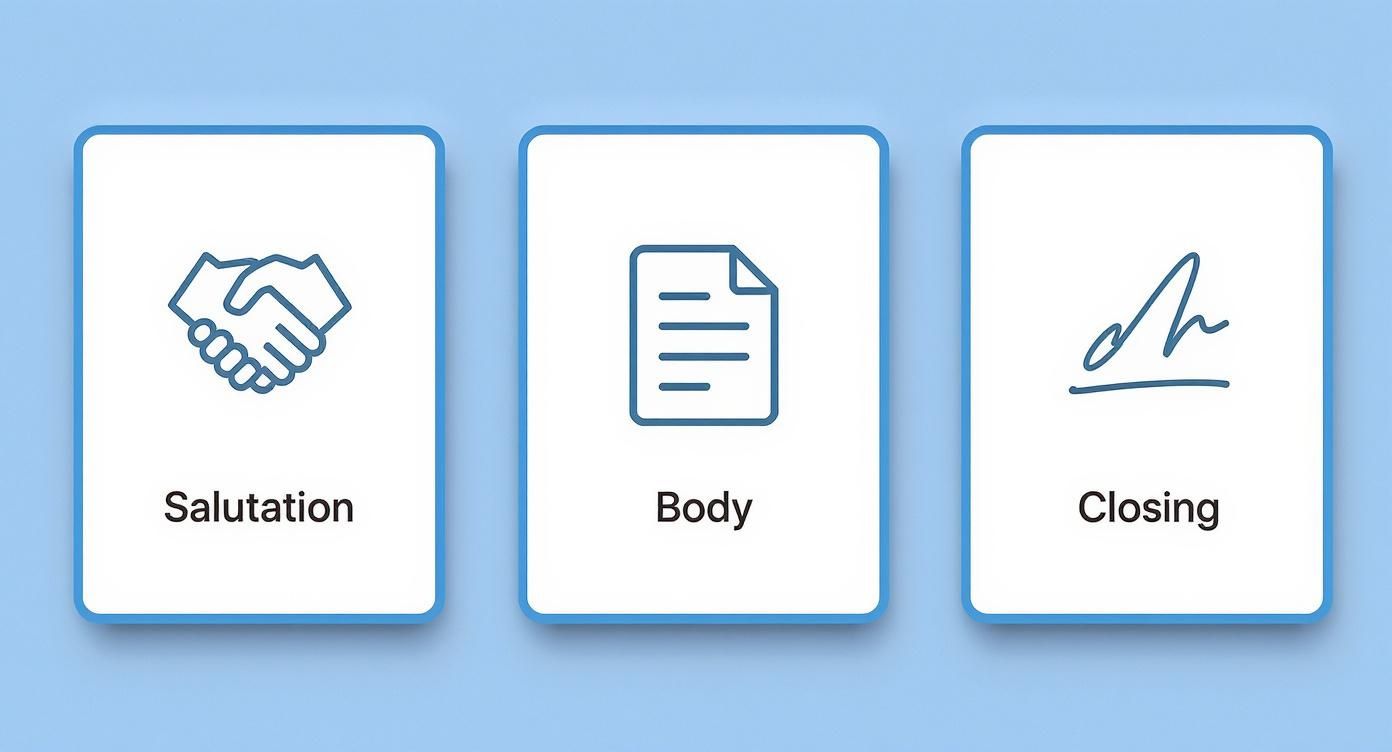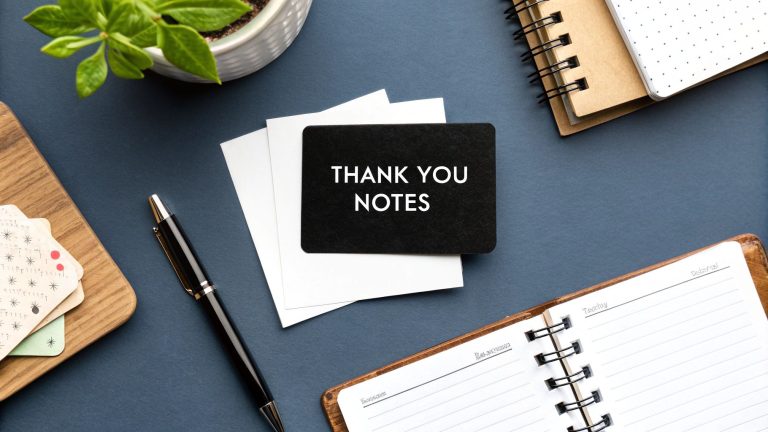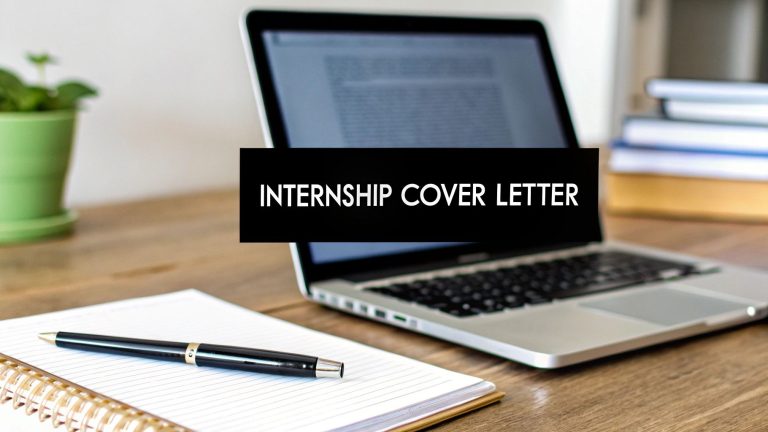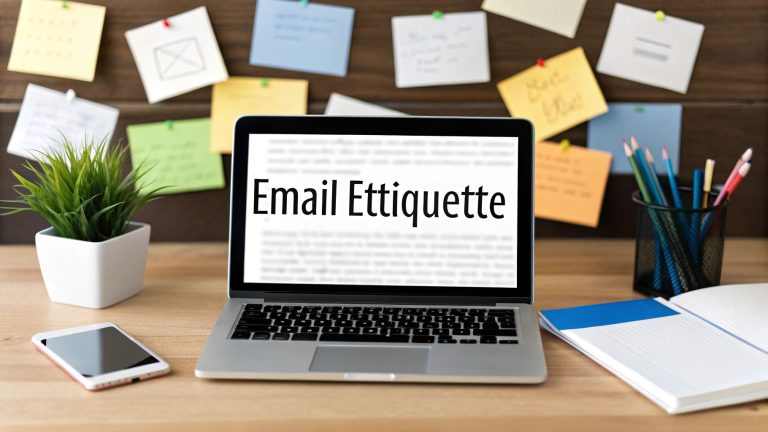A journal submission cover letter is your personal introduction to a journal editor. It’s more than just a formality; it’s a direct, professional pitch that explains why your research matters, why it's a perfect fit for their journal, and ultimately, why it deserves to be published.
Think of it as the handshake before the conversation. It's your first, and sometimes only, chance to make a strong case for your work before the editor even glances at your abstract.
Why Your Cover Letter Is Your First Test

Your cover letter is the very first hurdle in the race to publication. For a busy editor, it’s a quick-glance tool they use to gauge your research potential and your professionalism long before they dive into the actual manuscript.
This isn't just about ticking a box in the submission portal. It's about making a strategic first impression. A well-crafted, compelling letter can put your paper on the fast track to peer review. On the other hand, a generic or sloppy one can lead to a swift desk rejection, even if the science behind it is solid.
The Editor’s First Filter
Journal editors are the gatekeepers of academic literature, often juggling hundreds of submissions at a time. Your letter helps them answer a few critical questions right away:
- Does this fit our journal? The letter must immediately show a clear connection between your research and the journal’s specific scope and readership.
- Is this research important? You need to clearly state the gap your study fills and why your findings are a big deal for the field.
- Is this author professional? A clean, well-written, error-free letter signals attention to detail and respect for the process.
If your letter can't answer these questions clearly and concisely, your manuscript starts at a serious disadvantage.
The Power of a Strong First Impression
Don't just take my word for it. In a survey of 1,200 journal editors, a staggering 87% said they always read the journal submission cover letter before deciding whether to send a paper for peer review. That single statistic says everything you need to know about its importance.
Before diving into the nitty-gritty of your paper, editors are looking for specific cues in your letter. They want to see that you've done your homework and understand their journal's mission.
What Editors Are Really Looking For
Here’s a quick breakdown of what an editor is scanning for when they first open your cover letter and what each element tells them about you and your work.
| Element | What It Signals to an Editor |
|---|---|
| Correct Editor & Journal Name | You've done basic research and aren't just mass-submitting. |
| Clear Statement of Novelty | You understand what makes your work stand out in a crowded field. |
| Direct Link to Journal Scope | You respect their readership and can articulate why your paper fits. |
| Concise Summary of Findings | You can communicate your key results effectively. |
| Declaration of Exclusivity | You are following standard ethical submission guidelines. |
| Professional Tone & Formatting | You are a serious, detail-oriented researcher. |
This table shows that every part of your letter sends a message. Make sure it's the right one.
Your cover letter isn't just a summary of your manuscript; it's a persuasive argument for its publication. It tells the editor not only what you did but, more importantly, why it matters.
A thoughtful letter sets a collaborative tone and shows the editor you’re a professional. While the fundamentals are universal, you can learn a lot from similar high-stakes writing, like the strategies for a winning cover letter used in grant applications, where persuasion is everything.
Ultimately, strong professional communication is a non-negotiable skill for any researcher. If you want to sharpen your abilities beyond academia, our guide on https://lettergenerator.co/professional-letter-writing/ is a great place to start. Your cover letter is the first test—passing it is what gets you to the next stage.
Building the Foundation of Your Letter
Think of your cover letter not as a writing assignment, but as a blueprint. Every strong journal submission letter is built on a clear, logical structure. Each part has a job to do, and when they all work together, the letter effectively introduces your manuscript and convinces the editor it’s worth their time.
This isn't about being rigid; it’s about being clear. A rambling, disorganized letter can signal to a busy editor that the manuscript might be just as messy. By following a conventional format, you make it easy for them to find what they need and quickly grasp the value of your work.
Starting with a Professional Salutation
The first words you write set the entire tone. Aim for respectful, direct, and professional.
First things first, find the editor's name. It’s almost always on the journal's website, usually under a tab like "Editorial Board" or "About Us." Taking a few minutes to do this shows you’ve done your homework and aren't just blasting out submissions to a generic list.
Address them formally using their title and last name.
- For example: "Dear Dr. Chen," or "Dear Professor Williams,"
What if you've looked everywhere and genuinely can't find a name? In that rare case, a role-based salutation is your best bet.
- Safe Alternative: "Dear Editor-in-Chief,"
Steer clear of outdated or overly generic greetings like "To Whom It May Concern" or "Dear Sir/Madam." They feel impersonal and can make your submission seem like an afterthought.
Crafting a Clear and Direct Opening Paragraph
Your first paragraph needs to get straight to the point. Editors are busy people; they don't have time for a long, winding introduction.
In just a couple of sentences, you need to hit three key points:
- Your purpose: You’re submitting a manuscript for consideration.
- The title: State the full title of your manuscript.
- The article type: Is it an original research article, a review, a case report? Specify it.
Here's how that looks in practice:
"Please consider our manuscript, 'The Impact of Mitochondrial Dysfunction on Neurodegenerative Pathways in C. elegans,' for publication in The Journal of Cellular Biology as an Original Research Article."
This direct approach respects the editor's time and gives them all the essential information right up front. It’s a small detail that helps build a positive first impression.
The Essential Body Paragraphs
This is your pitch. The body of your letter is where you briefly explain what your research is about and, more importantly, why it matters. Two or three short paragraphs are all you need.
Start by summarizing your study's main research question and its key findings. You don't need to get lost in the weeds with technical jargon here. Just give a clear, high-level overview that anyone in the field can quickly understand.
The next paragraph is the most important one. This is where you explain the significance of your work. What gap does your research fill? How does it move the conversation in your field forward? You’re connecting your results to the bigger picture and showing the editor why their readers will care. If you want to dive deeper into getting this part just right, you can find more guidance on the overall letter framework in our detailed article on cover letter structure examples.
Closing with Professionalism and Required Statements
Your closing should be clean, professional, and to the point. Thank the editor for their time and consideration, and then move on to any mandatory declarations the journal requires.
You’ll often need to include a few standard statements:
- Confirming the work is original and hasn't been published before.
- Stating that the manuscript is not currently under review at another journal.
- Declaring that all authors have approved the submission.
A global analysis found that 92% of leading academic journals explicitly require a cover letter, so it's a standard professional hurdle you have to clear. Including these formal declarations, often detailed in the author guidelines, shows you understand and respect the ethics of academic publishing. You can read the full analysis on cover letter expectations at Taylor & Francis Author Services.
Finally, wrap it up with a professional sign-off like "Sincerely," or "Yours respectfully," followed by your name, title, affiliation, and contact info. This simple, solid structure ensures your letter is comprehensive, professional, and easy for any editor to process.
How to Frame Your Research Contribution
This is where your cover letter shifts from a formality to your most important sales pitch. The structure is simple, but what you put inside it makes all the difference. You've got one shot to convince a busy editor that your manuscript isn't just another file in their queue—it's a critical piece of work their readers need to see.
Simply listing your findings won't cut it. You have to weave a story. Your mission is to pinpoint a specific, nagging gap in the current literature and then show, with absolute clarity, how your research is the missing piece.
Think of it in three parts: a professional opening, a persuasive body, and a clean closing. The real work happens in the middle.

This structure is your vessel. Now, let’s fill it with a message that lands.
From Finding to Significance
Every research paper holds evidence. Your cover letter makes the closing argument. It’s your job to connect the dots for the editor so they can’t help but see why your work is so important.
Don't just state the "what." Explain the "so what."
Instead of saying, "We found a correlation between X and Y," you need to frame it in terms of its impact. Does this finding flip a long-held assumption on its head? Does it blow the doors open for a new therapeutic approach? Maybe it offers a brilliant new method that other researchers can immediately use.
Pinpointing the Gap in Knowledge
You can’t claim to fill a gap until you’ve clearly defined it. Vague phrases like "little is known about this topic" are a red flag to editors. They're weak, unconvincing, and suggest you haven't done your homework.
Get specific. Show the editor you know the landscape of the literature inside and out.
- Weak Phrasing: "This paper adds to the literature on…"
- Strong Phrasing: "While previous studies have established a link between protein A and disease B, the underlying mechanism has remained elusive. Our work is the first to identify and characterize the signaling pathway that connects them."
That second example instantly signals novelty and importance. You’ve demonstrated a deep understanding of the field and exactly where your work fits. Keeping this statement both powerful and concise is crucial. For more on this, our guide on how long a letter of interest should be offers some great parallels.
Articulating Your Unique Contribution
After you’ve defined the gap, it’s time to land the punch. This is where you state exactly how your findings solve the problem or answer the unanswered question.
Let's see this in action:
- Biochemistry Example: Don’t just say, "We identified a new enzyme." Instead, try: "Our discovery of the enzyme Catalyzin provides the first viable target for developing inhibitors to treat a rare metabolic disorder that currently has no effective treatment."
- Sociology Example: Move beyond, "We conducted a survey on social media use." A better pitch is: "Our longitudinal study reveals a causal link between specific social media behaviors and declining civic engagement, challenging the prevailing narrative that these platforms foster community connection."
See the difference? These statements articulate direct impact. The skills used in securing research grants are very similar; in both cases, you have to argue for the value and real-world significance of your work.
Your goal is not to re-write your abstract. It's to provide the context that makes your abstract irresistible. The editor should finish this section knowing precisely what your paper offers that no other does.
Tailoring Your Pitch to the Journal
The final, crucial step is to connect your contribution directly to the journal you’re targeting. Your research needs to be important, yes, but it must be important for their specific audience.
Start by reading the journal's "Aims and Scope" section. Better yet, skim the titles and abstracts of a few recent issues. Get a feel for the conversation the journal is having, and then show how your paper joins that conversation.
- For a clinical journal, focus on the implications for patient care.
- For a methodological journal, highlight your technique’s novelty and wide applicability.
- For a theoretical journal, explain how your findings extend or challenge a key theory.
Here’s a look at how to take a generic statement and make it resonate with a specific journal.
From Vague Statement to Powerful Pitch
This table shows a side-by-side look at how to transform generic descriptions of your research into specific, compelling statements that capture an editor's interest.
| Generic Phrasing (Avoid This) | Impactful Phrasing (Use This) |
|---|---|
| "Our findings will be of interest to a broad audience." | "Given the journal's focus on translational medicine, our findings on this novel drug delivery system will be of immediate interest to your clinical readership." |
| "This research contributes to the field of neuroscience." | "Our work directly complements the recent article by Dr. Smith (2023) in your journal, providing the mechanistic explanation for the behavioral observations they reported." |
By tailoring your message, you’re not just submitting a manuscript; you’re starting a conversation with a colleague. It shows respect for the journal and a deep understanding of your field. This small effort can be the thing that gets your foot in the door.
Getting the Formalities Right
You've nailed the pitch and highlighted your groundbreaking research. Now it’s time to button up the details. The final stretch of your cover letter handles the administrative declarations, and while they might feel like a box-ticking exercise, they are absolutely crucial.
Think of this section as your final professional handshake. Getting these small but vital details right shows the editor you’re serious, thorough, and understand the rules of academic publishing. It avoids unnecessary delays and, frankly, keeps you out of the immediate rejection pile.
Stating Originality and Exclusivity
This is the big one. Every editor needs to know that the manuscript they’re about to spend hours reviewing is original and isn't sitting in someone else's inbox. It’s a fundamental rule of publishing.
You don’t need to be fancy here. A simple, direct statement does the job perfectly.
We confirm that this manuscript is original, has not been published elsewhere, and is not currently under consideration by another journal.
That’s it. This single sentence reassures the editor that your submission is exclusive to their journal, which is a non-negotiable starting point.
Declaring Conflicts of Interest
Transparency is everything in academic research. You have to be upfront about any potential conflicts of interest—anything that could even remotely be seen as influencing your findings. This can include financial ties, professional relationships, or anything else that might muddy the waters.
If you have none, keep it simple.
- No Conflicts: "The authors declare no potential conflicts of interest."
If you do have something to report, be direct and concise. Don't hide it or hope no one will notice.
- With Conflicts: "Author A has received research funding from XYZ Corporation, which is also detailed in the manuscript's acknowledgments. All other authors declare no conflicts of interest."
Being honest here is about protecting your own reputation just as much as it is about the journal's integrity.
Acknowledging Funding and Contributions
Did you receive a grant to fund this work? Your funding agency and the journal will expect you to acknowledge it. Make sure you include the name of the funding body and the specific grant number.
Many journals also now require an author contribution statement. This is just a clear breakdown of who did what—from the initial idea and data collection to the writing and final edits. It’s about giving credit where it’s due.
- Funding Example: "This research was supported by the National Science Foundation under Grant No. [Your Grant Number]."
- Contributions Example: "All authors have read and approved the final manuscript. A detailed breakdown of author contributions is included within the manuscript."
These final declarations show you've covered all your bases. For more general advice on arranging these elements neatly on the page, check out this guide on how to format a letter. By handling these formalities with care, you let the editor focus on what truly matters: the quality of your research.
Cover Letter Mistakes That Will Get You Rejected

Even the most brilliant research can get stopped dead in its tracks by a bad cover letter. I've seen it happen. These common, and totally avoidable, errors can get your manuscript rejected before a peer reviewer ever lays eyes on it.
Think of it this way: the letter is your first handshake with the editor. If you get it wrong, it suggests a lack of care that they'll assume carries over into your research.
It's no secret that researchers pour a lot of time into this one document. A major survey found that 68% of authors spend at least two hours drafting their cover letter, and a dedicated 22% spend more than five hours on it. With that much at stake, you can't afford to let a simple mistake undermine all that effort. You can see more on this from Elsevier's author support resources.
Let's walk through the most common pitfalls I see and, more importantly, how you can sidestep them.
Sending the "One-Size-Fits-All" Letter
Want to get a desk rejection fast? Send a generic letter. Editors can spot a copy-and-paste job from a mile away, especially when it doesn't even mention their journal by name or explain why your work fits their specific audience.
This immediately signals that you're just carpet-bombing journals, hoping something sticks. It’s the academic version of junk mail, and it’s just as effective.
- What it says to an editor: "I haven't bothered to read your journal."
- How to fix it: Always, always customize your letter. Name the journal, explain why your research is a perfect match for its aims, and if you can, reference a relevant article they published recently. It shows you've done your homework.
Sloppy Typos and Messy Formatting
Nothing torpedoes your professionalism faster than typos, grammar mistakes, or sloppy formatting. These are huge red flags for an editor. If your cover letter is a mess, they’re left to wonder if your manuscript is just as careless.
Your letter is a direct reflection of your meticulousness as a researcher. Make sure it's flawless.
From an Editor's Desk: "When I see a cover letter with typos, it tells me one of two things: the author rushed it, or they lack attention to detail. Neither gives me confidence in the manuscript that follows."
Proofread your letter. Then proofread it again. Reading it out loud is a great trick for catching awkward sentences, and it never hurts to have a trusted colleague give it one last look. For more general advice, our article on professional email writing tips has some great pointers.
Hyping Up Your Findings
It's good to be confident in your work, but there’s a big difference between confidence and hype. Steer clear of clichés like "groundbreaking" or "paradigm-shifting" unless your findings truly are. Editors are naturally skeptical of over-the-top claims—they've heard it all before.
Let your research speak for itself. Be direct and honest about what you've contributed to the field without sounding arrogant.
- Don't say: "This study completely revolutionizes our understanding of the field."
- Instead, try: "Our findings challenge a long-held assumption in the field by providing the first evidence of…"
See the difference? The second version is strong, specific, and professional.
Copying and Pasting Your Abstract
This one is a classic mistake. The cover letter is not the place to just copy and paste your abstract. They serve two completely different functions. The abstract is a formal summary of your research; the cover letter is your personal pitch to the editor.
Use the letter to give the context that the abstract can't. This is your chance to explain the "so what?" of your research and make a direct case for why it belongs in this journal. You're not just summarizing your paper—you're selling its importance.
Your Questions About Cover Letters Answered
https://www.youtube.com/embed/ZfmVSFg_zSI
Even after you've spent weeks polishing your manuscript and drafting what feels like a solid cover letter, a few small questions can pop up at the last minute. It happens to everyone.
Let's walk through some of the most common practical things researchers wonder about. Getting these details right can make a real difference in how professionally your submission comes across.
How Long Should a Journal Submission Cover Letter Be?
Keep it short and sweet. Your cover letter should never be more than a single page, and the sweet spot is usually between 300 and 400 words.
Think of it this way: editors are juggling dozens of submissions. A concise, direct letter that gets straight to the point is a sign of respect for their time. A great approach is to stick to a simple four-paragraph structure:
- Paragraph 1 (The Hook): State your manuscript's title and that you're submitting it for consideration.
- Paragraph 2 (The Pitch): Briefly explain the research gap you're addressing and what makes your findings important.
- Paragraph 3 (The Fit): This is crucial. Connect the dots for the editor—why is your work a perfect fit for their journal and their readers?
- Paragraph 4 (The Formalities): Add the required declarations and a professional sign-off.
Anything more than that, and you risk the editor just skimming it. Make every word count.
Is It Okay to Use a Template for My Cover Letter?
Absolutely. Using a template to get the structure right is a smart move and can save you a ton of time. But—and this is a big but—you have to customize it for every single journal.
Editors can spot a copy-and-paste job from a mile away. It sends the wrong message, suggesting you haven't really thought about why you're submitting to their publication.
Here's how to make a template your own:
- Always use the journal's full name.
- Find and use the correct editor's name and title.
- Write a sentence or two that specifically explains why your study aligns with the journal's scope or recent publications.
A cover letter template gives you the skeleton. The details you add—the journal's name, the editor's title, the specific reason for fit—are what give it life and make it convincing.
Who Do I Address the Letter to If I Cannot Find a Name?
First, always do your homework. Scour the journal's website, looking for pages like "Editorial Board," "About Us," or "Journal Information." Taking a few extra minutes to find the right name shows you're thorough and professional.
Sometimes, though, a specific name is just impossible to find. When that happens, you can fall back on a professional, role-based greeting.
These are perfectly acceptable options:
- "Dear Editor-in-Chief,"
- "Dear Handling Editor,"
- "Dear Editorial Board,"
Just be sure to avoid old-fashioned and impersonal greetings like "To Whom It May Concern" or "Dear Sir/Madam." They feel dated and can give the impression you didn't even try to find a name.
Should I Suggest Potential Reviewers in My Letter?
Only if the journal explicitly asks for them. Read the "Instructions for Authors" section on the journal's website carefully. Many modern submission portals now have a separate field where you're prompted to enter reviewer suggestions, so there's no need to put them in the letter itself.
If the guidelines do ask for suggestions, list three to five experts in your field. The key here is to choose people who are unbiased and have no conflicts of interest. For each one, provide their name, affiliation, and email address.
If the journal guidelines don't mention it, don't include it. Keeping your journal submission cover letter clean and focused on your research pitch is always the best strategy.
Crafting the perfect letter can be time-consuming. AI Letter Generator can help you create a polished, professional draft in seconds. Just provide your key details, choose a tone, and let our tool build a strong foundation for your journal submission cover letter. Get started for free at https://lettergenerator.co.






